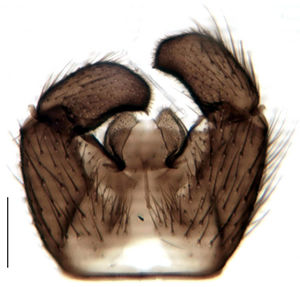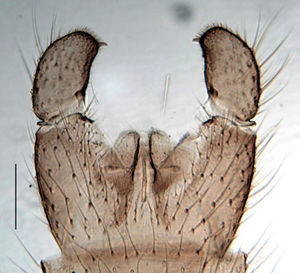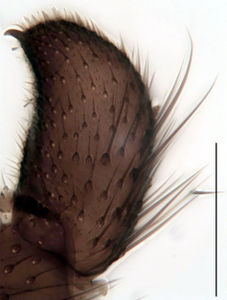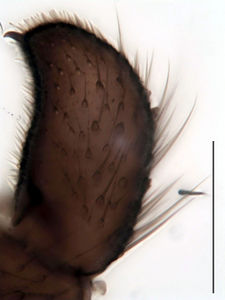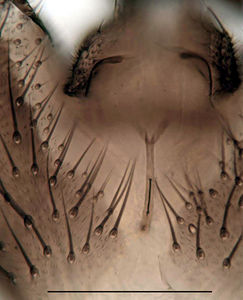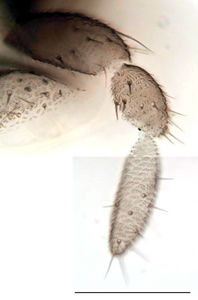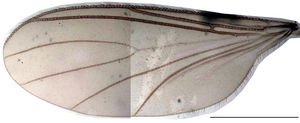Trichosiopsis subviatica
Ordo: Diptera
Familia: Sciaridae
Genus: Trichosiopsis
Name
Trichosiopsis subviatica Mohrig & Menzel, 1997 – Wikispecies link – ZooBank link
- Leptosciarella (Leptosciarella) subviatica Mohrig & Menzel, 1997[1]: 77. fig. 25
- Sciara elongata Winnertz, 1867[2]: 49
Type material
Holotype: ♂, in PWMP, leg. Gusakova, 27.04.1974
Type locality
Russia, Khabarovsk region, Nature Reserve Khekhtsyr
Other material studied
France: 1 ♂, Marais de Lavours, prairie, Malaise trap, Withers, 21.-30.06.2009; Germany: 1 ♂, Baden-Württemberg, Belchen, Malaise trap, Doczkal, 7.-28.05.2003, PKHH 5031; 1 ♂, Malsch, Heckelbachklamm, Malaise trap, Doczkal, 16.9.-08.01.2004, PASS 59; 1 ♂, Bavaria, Lindau, forest at shore of Lke Constance, sweep netting, Heller, 27.05.2004, PKHH 4208; 1 ♂, North-Rhine-Westphalia, Cologne, district Dünnwald, Malaise trap, Franzen, 9.-16.05.1989, PKHH 1241; 1 ♂, Cologne, district Poll, garden, Malaise trap, Franzen, 10.-17.04.1990, PKHH 2952; 1 ♂, 24.4.-01.05.1990, PKHH 2923; 1 ♂, 29.5.-05.06.1990, PKHH 2950; 1 ♂, 17.-24.07.1990, PKHH 2965; 1 ♂ 1 ♀, 28.8.-04.09.1990, PKHH 2969; 1 ♂, 14.-21.05.2002, PKHH 4262; 2 ♂, 21.-28.05.2002, PKHH 4264; 1 ♂, 20.-27.08.2002, ZSMC 2061; 1 ♂, Krefeld, Winnertz, ZFMK 26 [Holotype of Sciara elongata Winnertz, 1867]; 1 ♂, Rhineland-Palatine, Gönnersdorf, Eifel, orchard, Malaise trap, Cölln, 30.4.-07.05.1994, PKHH 1901; 5 ♂, Kirchheimbolanden, Nature Reserve Albertskreuz, Malaise trap, Doczkal, 23.5.-07.06.2002, PKHH 4885/4888/4889/4892; 1 ♂, Schleswig-Holstein, Flensburg, Marienhölzung, forest, Malaise trap, Barkemeyer, 17.-24.05.1996, PKHH 2054; 1 ♂, Heikendorf, garden, Malaise trap, Heller, 19.-27.04.1997, PKHH 2330; 1 ♂, 22.-28.06.1997, PKHH 2460; 1 ♂, 10.05.1991, PKHH 21; 1 ♂, Kiel University, garden, Malaise trap, Heller, 5.-12.05.1995, PKHH 1015; 2 ♂, Wankendorf, old beech stump, photoeclector, Warning, 22.5.-05.06.1989, PHKK 8; 1 ♂, Thuringia, Hainich National Park, mixed forest at Thiemsburg, sweep netting, Heller, 18.06.2005, PKHH 4359 [as Leptosciarella rejecta (part.) in Menzel & Heller (2006[3]; 55)]; Greece: 1 ♂, Kerkini, Kerkini Lake, Malaise trap, Ramel, 4.-10.04.2005, PKHH 5732; Hungary: Heves, Szilvásvarad, Bükki Nemzeti Park, sweep netting, Rulik, 22.05.1998, PWMP 4032 [as Leptosciarella rejecta (part.) in Rulik et al. (2001[4]: 241)]; Morocco: 1 ♂, Quirgane, garden, Malaise trap, Kassebeer, 21.-29.03.1996, PKHH 1954; Russia: 1 ♂, Altay Region, Artybash, pine and birch forest, sweep netting, Heller, 01.07.2005, PKHH 4426; 1 ♂, Malaise trap, Komarova, 01.-04.07.2005, PKHH 4684; Slovakia: 2 ♂, Ivanka pri Dunaji, Obstgarten, Kozanek, 22.04.1992, PKHH 620; Sweden: 1 ♂, Hälsingland, Stensjön-Lomtjärn, marsh pine wood close to bog, Malaise trap, Swedish Malaise Trap Project, 15.-29.06.2005, PKHH 7933; 4 ♂, Öland, Skogsby, Gamla Skogsby (Kalkstad) "diversitetsängen", meadow with bushes, Malaise trap, Swedish Malaise Trap Project, 20.5.-28.06.2006, NHRS 2554, 2643; PKHH 6598, 6599; 14 ♂, Östergötland, Omberg, Boskogsreservatet Omberg: beech forest, Malaise trap, Swedish Malaise Trap Project, 28.5.-05.07.2005, NHRS 1496-1501, 1584-1587; PKHH 6052; 1 ♂, Storpissan: old Norway spruce wood, Malaise trap, Swedish Malaise Trap Project, NHRS 2147; 3 ♂, Skåne, Simrishamn, Stenshuvud National Park: Svabeholmsskog, hornbeam forest, Malaise trap, Swedish Malaise Trap Project, 22.5.-20.06.2005, PKHH 7230, 7243, 7256; 1 ♂, Södermannland, Södertälje, Tullgarns näs, Rävsalaviken, mixed forest next to pasture, Malaise trap, Swedish Malaise Trap Project, 3.7.-19.08.2004, PKHH 7475; 2 ♂, Uppland, Biskops-Arnö, northern beach, elm grove, Malaise trap, Swedish Malaise Trap Project, 20.6.-18.07.2005, PKHH 7376; NHRS 4551; Switzerland: 1 ♂, Zurich, Sihlwald, window trap, Schiegg, 24.4.-11.05.1996, PKHH 1545 [in Schiegg et al. (1999: 80)[5] as Leptosciarella yerburyi part.]; 1 ♂, 24.05-19.06-1996 PKHH 2421.
Description (male)
Head. Eye bridge 5 rows of facets. LW-index of 4th antennal flagellar segment 2.3–2.6; neck 0.32–0.45 of segment width; Transition of basal part to neck pronounced. Colour of neck unicolour. Antennal hairs shorter than segment width; dense; salient. Palps darkened; normal; palpomeres 3. First palpomere of normal shape, or thickened; with 6–8 bristles; with only some sparse sensillae. Second palpomere shortly oval. Third palpomere as long as first segment. Thorax. Colour very dark, or brown. Notum unicolorous. Thoracic setae long and strong; dark. Mesonotum with some weaker central bristles. Posterior pronotum bare, or setose. Postpronotal setae 0–2; fine. Laterotergite bare. Legs. Colour yellow-brown, or brown. Hind coxae darkened. Hairs on fore coxae black. Front tibia apically with a patch of setae. Front tibial organ dark. Front tibial organ not bordered. Tibial setae on hind legs normal, shorter than tibial width. Tibial spurs of equal length. Claws untoothed. Wings. Wings slightly darkened; of normal shape. Wing membrane without macrotrichia. Wing venation weak, with faint m-base. M-fork of normal shape. R1 inserting at or slightly before base of m-fork; posterior veins with macrotrichia; stM mainly with macrotrichia; cuA1 and cuA2 mainly with macrotrichia; bM bare; r-m with a few setae, or mostly setose; bM:r-M 1.05–1.3; st-Cu:bM 0.3–0.4; r1:r 1.65–2; C:w 0.68–0.8. Halteres dark; of normal length. Abdomen. Abdominal setae strong and dense; dorsally dark; ventrally dark. Hypopygium concolour with abdomen; 0.64–0.8 × longer than wide. Base of gonocoxites with strong setae; gonocoxites broadly separated; inner margin of gonocoxites normally U-shaped; inner part of hypopygium scarcely setose; elongated setae on valves of hypopygium absent. Gonostylus 2–2.2 × longer than wide; Inner margin concave; apex equally rounded. Apical tooth present; 2.05–2.4 × longer than broad; normal. Awl-like setae normal; below apex present. Megasetae on inner part of gonostylus absent. Whiplash-hair absent. Tegmen 0.5–0.7 × longer than broad; rectangular with rounded edges; normal; Central process absent. Length of aedeagus/hypopygium 30–45 %; Aeadeagal apical structure present. Measurements. Body size 3,5–4.5 mm. Hind tibia 1.75–2 mm. Wing length 3–3.6 mm.
Diagnosis
Trichosiopsis subviatica is a very dark and strongly setose species. The shape of the dorsally equally rounded gonostyles resembles those of Trichosiopsis viatica, but the gonostyli are slightly more slender. The species can also be separated by the darker colour of legs, thorax and halteres and by the dark setae on the fore coxae and also the the longer aedeagus. The hypopygium bears some strong basal setae, which make Tr. subviatica appear similar to Trichosiopsis subpilosa, which otherwise is nearly identical, but has the strong setae on conspicuous lobe-like extensions. The species is regionally variable. Some of the Swedish specimens have more slender gonostyli and a stronger apical tooth, whereas in the Southern Palaearctic specimens the apical tooth is longer, but at present no further specific or subspecific differentiation is possible.
DNA Barcoding
The COI sequence is assigned to BIN BOLD:ACK0022 (average distance 1.05%, max. 2.25%, n=17, K2P: 9.79%).
Etymology
lat. sub- = under, beneath; lat. viaticus = travelling. The name makes reference to the similarity to Leptosciarella viatica.
Ecology
In contrast to Tr. viatica Trichosiopsis subviatica is apparently not restricted to dead wood as it is frequently found in urban ecosystems and gardens.
Discusssion
Trichosiopsis subviatica has not been recognized as a distinct species for a long time, although it is quite abundant and widespread. The synonymy with Sciara elongata Winnertz, 1867 is confirmed by comparison of the hypopygium of the lectotype (Fig. 3) with recent material. The long and slender aedeagus, the dorsally evenly rounded gonostyles and the setae at the hypopygial base are typical for Tr. subviatica and not for Tr. rejecta as which it was identified by Menzel & Mohrig (1997: 63[1]). Tr. rejecta has still longer setae at the hypopygial base. The rest of the lectotype specimen is lost. Despite of the new synonymy the younger name subviatica remains valid, because Sciara elongata Winnertz, 1867 is a primary junior honomym of Sciara elongata Bouché, 1834.
Distribution
Germany[6], France, Great Britain[7], Greece, Hungary, Morocco, Norway[8], Russia[1], Slovakia[1], Sweden[9], Switzerland.
Images
|
References
- ↑ 1.0 1.1 1.2 1.3 Mohrig, W.; Menzel, F. 1997: Revision der paläarktischen Arten von Trichosia Winnertz sensu Tuomikoski, 1960 (Diptera, Sciaridae). – Teil II. Gattungen Leptosciarella Tuomikoski, 1960 und Trichodapus gen. nov. Studia dipterologica, 4(1), 41–98.
- ↑ Winnertz, J. 1867: Beitrag zu einer Monographie der Sciarinen. W. Braunmüller, Wien. BHL
- ↑ Menzel, F.; Heller, K. 2006: Trauermücken (Diptera: Sciaridae) aus dem Nationalpark „Hainich“ (Thüringen) nebst der Beschreibung von Scatopsciara andrei Menzel spec. nov. Studia dipterologica, 13(1), 45–59.
- ↑ Rulik, B.; Mohrig, W.; Jaschhof, M. 2001: Trauermücken (Diptera: Sciaridae) und freilebende Gallmücken (Diptera: Cecidomyiidae: Lestremiinae) aus Ungarn. Mit Bemerkungen zur Corynoptera tridentata-Gruppe. Folia Entomologica Hungarica, 62, 231-245.
- ↑ Schiegg, K.; Obrist, M.; Duelli, P.; Merz, B. et al. 1999: Diptera and Coleoptera collected in the Forest Reserve Sihlwald ZH. Mitteilungen der Schweizerischen Entomologischen Gesellschaft, 72, 289-302.
- ↑ Heller, K. 2004: Eine Bestandsaufnahme der Sciaridae (Diptera) Schleswig-Holsteins mit Ergänzungen und Korrekturen zum bisher bekannten Arteninventar. Faunistisch-Ökologische Mitteilungen, 8, 233–257.
- ↑ Menzel, F.; Smith, J.E.; Chandler, P. 2006: The sciarid fauna of the British Isles (Diptera: Sciaridae), including descriptions of six new species. Zoological Journal of the Linnean Society, 146, 1-147. PDF
- ↑ GBIF Trichosiopsis subviatica
- ↑ Heller, K.; Vilkamaa, P.; Hippa, H. 2009: An annotated check list of Swedish black fungus gnats (Diptera, Sciaridae). Sahlbergia, 15(1), 23-51.

